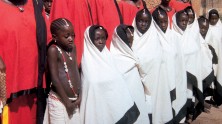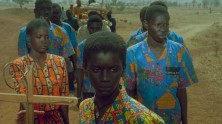


Ousmane Sembène, Cinematic Revolutionary
I’m not a militant of any party, I’m a militant through my art.
For many years, the Senegalese novelist and filmmaker Ousmane Sembène (1923-2007) refused to release his films on video and DVD. Thus, opportunities to see films by the "father of African cinema" have been few and far between, compounded by the racism that relegates pioneering Black and African directors to history's margins. Sembène was a firm believer in the big screen. He came of age in Senegal's segregated cinemas, which he attended almost every day. It was in one such theater that he encountered the paradoxical beauty of Leni Riefenstahl's Olympia (1938), one of few films he would later name as an influence.
What Sembène valued most about seeing his own films in the cinema was sitting with an audience, "to smell different perfumes, to see people smiling, to know that people will go to dinner afterwards and talk about what they have seen." Intent on reaching the masses, he often traveled to rural areas with his own equipment to project and discuss the films himself. The Harvard Film Archive's retrospective invites audiences to see these under-appreciated films as the artist intended: in the cinema, together. The series features nearly all of Sembène's films, including Janus Films' recent 4K restorations of Mandabi (1968), Emitaï (1971), Xala (1975) and Ceddo (1977).
Like Sergei Eisenstein, the director he considered most important, Sembène rejected socialist realism in favor of a cinematic language both didactic in function and supple in style. He aimed directly at his targets—capitalism, neocolonialism, patriarchy, religion—with nimble montage, sumptuous mise-en-scène, freeze-frames and zooms, flashbacks and visions, blistering caricatures and frank depictions of sex and mortality.
Sembène's decision to become a filmmaker was the result of an epiphany he had on the Congo River, after independence swept through Africa in the early sixties. He had already defied expectations by becoming a novelist: previously he had been a mason, mechanic and construction worker in Dakar; a soldier for the Free French Army during World War II; and a docker and trade unionist in Marseilles. But Sembène knew that literature could only do so much in the face of widespread illiteracy in Africa. A dedicated Marxist-Leninist who believed art to be an essential part of revolutionary struggle, he determined that "cinema is the people's night school."
At thirty-nine-years-old, Sembène left Senegal for the Soviet Union's Gorky Studio. He avoided all theory courses and learned only the most essential technical skills, then returned after one year. It had been only three years since the overturning of the Laval Decree, a Vichy-era law that effectively disallowed African people from filming themselves. Though there were several pre-independence films by African filmmakers, most were neither commercially released nor filmed in Africa. This made Sembène one of the first sub-Saharan African filmmakers to make films in Africa for an African audience.
Under his production company Filmi Domirev, Sembène made the short film Borom Sarret (1963) with an old Soviet camera. The winner of the First Film Prize at the Touris Film Festival, Borom Sarret opens with a cheeky introduction: the name "Sembène Ousmane," described by scholar Jean Jonassaint as a pen name that subverts the colonial naming system of the school and the army. This name, which Sembène went on to use in all of his films, is a reminder of France’s many failed attempts to colonize the mind. The reference to colonial schooling is an especially pointed one for Sembène, who was expelled at fourteen for striking back at a racist and violent French teacher.
That Sembène's next three films—Niaye (1964), La Noire de... (1966), and Mandabi (1968)—were adaptations of his own short stories that proved his urgency and command of both mediums. Though he carried over the themes of his literary works, Sembène flexibly applied perspectival and chronological changes to his texts, enlivening them with dynamic compositions and voiceover. Throughout the sixties, Sembène broke ground for accomplishing numerous firsts. A charge against the neocolonial exploitation of African workers, La Noire de... (1966) was the first African film to win the Prix Jean Vigo. The following year, he served as the first African member of the jury at the Cannes Film Festival.
In 1968, Sembène's Wolof-language satire Mandabi became the first feature film shot entirely in an African language. Mandabi marked a departure from Sembène's previous films, which required him to subvert the coproduction requirement of French dubbing by using French voiceover as a symbol of colonial violence.
Despite these triumphs, securing funding remained a difficult and unpredictable process for Sembène. After the screenplay for La Noire de... was rejected by the Ministry of Cooperation's Film Bureau (which provided funding to francophone African productions), Sembène shaved the film down to one hour to satisfy the requirements of the Centre national du cinéma (CNC). In the case of Mandabi, the film's French producer—whose participation was required by the CNC—demanded nudity, causing a difficult legal battle when Sembène refused.
Though he understood the contradictions of accepting American or European funding, Sembène often stated that he was ready to "sleep with the devil or she-devil to make my films." He coined the term mégotage (or “cigarette-butt cinema") to describe the absolute necessity of resourcefulness in African filmmaking. In the spirit of mégotage, Sembène experimented with coproduction models that would provide sufficient resources without threatening his autonomy. The short film Tauw (1970), for instance, was commissioned by an American church—an irony for the atheist Sembène, who used the money to fund the historical epic Emitaï (1971).
Dedicated to "all the militants of the African cause," Emitaï (1971) signaled a shift towards increasingly provocative political critique and a narrative structure derived from collective protagonists. Set in the forties, the film follows the raid of a Diola village by French officers and Senegalese tirailleurs. Whereas Sembène's preceding films focused on individual protagonists, Emitaï cuts from individual to individual and group to group, from death and back to life. The result is a film that is at times still and languid then brisk and forceful, exemplifying Sembène's distinct rhythm in prototypical form.
After Emitaï was banned across Africa, Sembène took even greater risks with Xala (1975) and Ceddo (1977), two films condemning the hypocritical African leaders who seek to benefit from neocolonialism. After the Senegalese government cut multiple scenes from Xala—a sex comedy that skewers a group of wealthy subcontractors, among them a blatant stand-in for President Léopold Senghor—Sembène responded by handing out fliers to audiences describing which scenes had been removed.
The Senegalese government again attempted to penalize Sembène for Ceddo (1977), which was officially banned due to the spelling of the title—a Pulaar word referring to a group of outsiders who resisted slavery and colonization. Sembène mortgaged his own house to fund Ceddo, which shows in vivid detail African participation in the slave trade. Slavery serves as the economic backdrop of the film's frightening narrative: a guileless African leader fails to protect his people from a slave trader, a Catholic priest, and an imam—the latter of whom gains an exceeding amount of control over the king's decisions.
Sembène attracted heavy criticism for depicting the introduction of Islam in West Africa as a threat to traditional beliefs and cultures. In the years of difficulty that followed, he prepared his passion project: a big-budget epic about the Mandingo chief Samory Touré. Unfazed by censures, he contended that his movies have "more followers than the political parties and the Catholic and Muslim religions combined. [...] The people will come whether they share my ideas or not."
Sembène had planned to retire after completing Samory. But when the project became mired in delays, he changed his retirement plans and returned with the Senegalese-Algerian-Tunisian co-production Camp de Thiaroye (1988). Co-directed by Sembène and Thierno Faty Sow, Camp de Thiaroye draws from Sembène’s experience as a soldier during World War II in its depiction of the 1944 Thiaroye Massacre. The film follows a platoon of West African veterans placed in a squalid military camp that uncannily resembles a German internment camp. Though it won the Grand Jury Prize at the Venice Film Festival, the film was banned in both Senegal and France.
Even when circumstances prevented Sembène from fully accomplishing his goal of a pan-African production and distribution model, his final films underscored the importance of self-determination. These are also his most meditative films, connecting conversations and encounters across web-like structures. Significant for the very private Sembène, a subtly personal dimension emerges within the work as well: the eponymous political dissident in Guelwaar (1992) who speaks out against foreign aid recalls Thomas Sankara, but there are traces of Sembène's own character as one who never held his tongue. And although the protagonist of Faat Kiné (2001) is a single mother, her ebullient pursuit of sexual and financial independence is not unlike Sembène's own lifestyle as a twice-divorced artist who valued his freedom.
The ever-productive Sembène planned for Faat Kiné to be the first in a trilogy dedicated to the heroism of everyday life. For the second instlalment, the Bambara-language film Moolaadé (2004), he pushed himself even further by filming in Burkina Faso with a pan-African cast and crew. Upholding his belief that “the future liberation of Africa will never happen without the liberation of women," Moolaadé denounces the practice of female genital excision. Though Sembène's health had rapidly deteriorated during the shoot, he remained persistent and optimistic about the future: At the time of his death in 2007, he was preparing to make Brotherhood of Rats, the last film in the trilogy.
Sembène frequently likened the artist’s role in society to that of the griot, a lower-caste oral storyteller whose knowledge of history gave him or her the power to publicly speak the truth and to point the finger at corrupt leaders. For Sembène, to follow in the footsteps of the griot was a commitment to question authority, instigate debate, and empower other African people to do the same. As a founding member of the Pan-African Federation of Filmmakers (FEPACI), and a co-founder of the Panafrican Film and Television Festival of Ouagadougou (FESPACO), he helped pave the way for independent and radical African cinema to stand its ground against Western cultural imperialism.
In his lifetime, Sembène introduced to the screen a striking array of actors, including Mbissine Thérèse Diop, Mamadou Gueye, Younousse Sèye, Ibrahima Sane and Thierno Ndiaye Doss. Sembène also made several appearances in his films, in far more demanding roles than the fleeting cameos of Alfred Hitchcock. He was visited by leaders, thinkers, and artists like James Baldwin, Angela Davis and W.E.B. DuBois. And to younger filmmakers like John Singleton, Med Hondo, Souleymane Cissé and Charles Burnett, he was a guiding light in the fight for Black and African self-representation.
The astonishing consistency of Sembène's filmography across four decades is a testament to his fortitude as a militant artist. That he has yet to be universally acknowledged as a central figure of the cinematic canon is one of many proofs that colonialism is alive and well today. But to encounter his films is to be continually heartened by the truth that another form of imagination not only exists but also towers over colonial ways of thinking, to plainly see that obstacles like budgetary restrictions or government censorship are superficial limits to the unique language of cinema. – Kelley Dong












